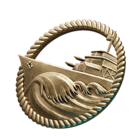German Destroyers Collection
This collection is dedicated to German destroyers and will inform you about the history of ships of this type, as well as the people who served on them. The German destroyers of World War II demonstrated that any ship design is a compromise, where in order to improve one characteristic, you have to sacrifice another. The Oberkommando der Marine—High Command of the Kriegsmarine—wanted to create high-speed ships with powerful weapons. To achieve that, seaworthiness, maneuverability, and propulsion had to be sacrificed.
Nonetheless, German destroyers actively took part in battles for the entirity of the war in regions that spanned from the Arctic to the Bay of Biscay. Our collection highlights some of the events from the history of this ship type and the people who served on them.
The overall collection comprises four sub-collections. Each sub-collection grants 24-hours Premium Account. There is a separate reward for obtaining all 16 items. Items may be bought for 4 duplicates.
Contents
Sub Collections
Destroyer Camouflages
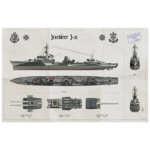
During World War II, camouflage on German destroyers started to be actively used only at the end of 1941. A two-color scheme was used—wide dark-gray stripes or black wedges were applied over the old paint.
The camouflage of Z-31 is based on a photo dating back to the end of 1942, when the new ship was at the end of a drill before heading to Norway, where she took part in battles until February of 1945. However, in July 1943, the commander of the 5th Emergency Flotilla of destroyers that operated in the Arctic asked for all of his ships to be painted a bright gray color.
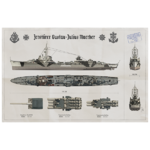
In 1942, Kriegsmarine destroyers started to use a three-color camouflage scheme increasingly often—mainly gray, with stripes of a darker color, and the fore and aft ends were painted white so as to give the impression of a shorter hull.
It's quite possible that this camouflage variant appeared on ships that served in the Arctic. Similar combinations were seen on several destroyers that were based in Norway in 1942. This combination became the foundation for the camouflage of Gustav-Julius Maerker.
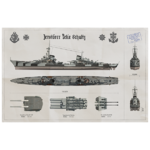
In 1943, an additional camouflage scheme for destroyers was accepted—a two- or three-color paint scheme in the form of converging stripes used to create the "vanishing point" effect. Sailors simply referred to it as "zebra". In this variant, the paint on both sides was identical as a rule. In an earlier version, the shapes on the port and starboard sides were often different.
The zebra camouflage scheme was applied to destroyer Felix Schultz. The scheme was quite widely used, but not for long.
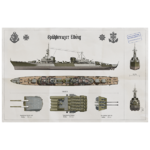
Spähkreuzer Elbing is represented in the earliest of the typical camouflage schemes for Kriegsmarine destroyers. Such camouflage was applied to Z-6 Theodor Riedel and Z-27 after they traveled to Norwegian waters at the turn of 1941, and to Z-26 during Operation Cerberus—the breakthrough of Scharnhorst and Gneisenau from Brest through the English Channel to Germany—in February 1942.
It's worth mentioning that there was no common opinion about the usefulness of camouflages in the Kriegsmarine, and from 1944, most destroyers didn't have any applied.
Reward
Completing this sub-collection provides the following reward:
![]() +24 hours Warships Premium time
+24 hours Warships Premium time
Destroyer Anti-Aircraft Artillery
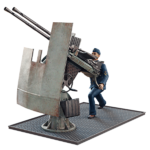
This automatic gun, manufactured by Rheinmetall until the very end of World War II, was equipped on Kriegsmarine ships as often as the Oerlikon machine gun of the same caliber was deployed on ships of the Allied powers. The base C/30 model suffered from misalignment and had a magazine of 20 shells, which was insufficient.
The improved 20 mm/65 C/38 gun received a 40-shell magazine, which reduced the reloading time. The gun was placed in single, twin, and quadruple mounts, including stabilized ones.
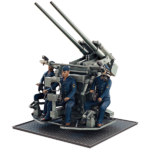
The 37mm /83 SK C/30 gun in a twin mount from 1934 was the primary short range AA gun of Kriegsmarine ships of all types, from destroyers to larger ships such as Bismarck and Graf Zeppelin. The low firing rate of the 37 mm semi-automatic guns with manual loading of individual shells was not enough to counter the growing capabilities of enemy aircraft.
It was decided to abandon the idea of modernizing the SK C/30 with an automatic loader developed by 1943. Instead, the guns were soon replaced by the new automatic Flak M/42 and M/43 of the same caliber.
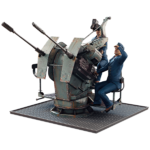
This 30 mm MK.103 AA gun manufactured by Rheinmetall had, arguably, the most devastating firepower among similar guns that were mass-produced during World War II. From 1944, the tower AA mount was produced by Mauser. The gun was placed on the carriage of a 20 mm Flak 38 AA gun.
Such single, twin, and quadruple guns were also used on self-propelled anti-aircraft weapons. To shoot down a twin-engine dive bomber or armored attack aircraft, it took two or three hits with tracer-fitted fragmentation shells, or one with a Flak 103/38 HE shell.
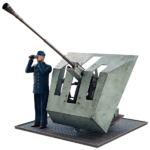
This medium-caliber AA gun was developed by Rheinmetall in 1944 specifically for automatic gun fire-control systems that worked in conjunction with surveillance radar. It was connected to power drives and ensured aiming based on data provided by an analog computer.
The 55 mm/77 automatic gun had a firing rate of 140 rounds per minute and was loaded with five-round chargers. It was planned to include such mounts in the AA defense systems of the 1942B and C, 1945-class destroyers that were being designed at the time. Three prototypes of the Gerät 58 gun were produced.
Reward
Completing this sub-collection provides the following reward:
![]() +24 hours Warships Premium time
+24 hours Warships Premium time
Destroyers and their commanders
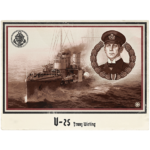
The Großes Torpedoboot 1913-class warships laid the foundation for the German Navy destroyers. They exceeded their predecessors in every aspect—they were larger, faster, and more seaworthy. For the first time, they had oil-burning boilers, as well as numerous powerful main battery guns and torpedo tubes. Large torpedo boat V-25 entered service on June 27, 1914. She was the first of 71 ships of her class—the largest ship series built for the High Seas Fleet.
Experienced destroyer commander, Corvette Captain Franz Wieting (1876–1966), was entrusted with bringing this ship into service. He spent the first 2 months of World War I on the bridge of V-25. Every day, they were expecting general engagement between the German and British fleets. In 1914, he was promoted.
The V-25-class ships became the work horses of the German Fleet during World War I, 32 of which were destroyed during the conflict. The lead ship was also the first of its kind. On February 13, 1915, V-25 hit a mine in the North Sea and sank. Franz Wieting outlived his ship. During the war, he commanded a destroyer flotilla. In the Reichsmarine, he was promoted to rear admiral, then led the German Navy in the North and Baltic seas. He retired in 1927, but returned at the beginning of World War II and served on land between 1939 and 1942. He finished his service as a vice admiral.
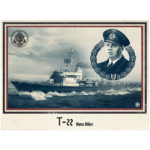
The 1939-class Flottentorpedoboote were, arguably, the most successful ships of their class in the Kriegsmarine. They were truly versatile in terms of their AA defenses, ASW, and mine defenses. They were distinctive for their seaworthiness and maneuverability, and became the most-used large German combat ships of the end-war period. The average length of service of fleet destroyers was just 13 months. Out of 15 ships that entered service between 1942 and 1944, 11 were destroyed.
The lead T-22 Flottentorpedoboote joined the Kriegsmarine on February 28, 1942, and soon after that, headed to the Bay of Biscay. She participated in fierce battles against the British forces that attacked German submarines and blockade runners as they entered the Atlantic. In June 1943, Captain Lieutenant Hans Blöse took command of the ship. He spent the entire war on the bridges of destroyers. As commander of Т-22, he proved himself in victorious battles in the English Channel. He also managed to survive the German defeat in the Bay of Biscay.
The ship was quite lucky with Blöse—in January 1944, Т-22 sailed to the Baltic and escaped destruction, unlike the same-class destroyers in the west that were sunk in the spring of the same year. But the commander was replaced in April, and lady luck abandoned the ship with him. Overnight, on August 18, 1944, Т-22 was destroyed by mines in Narva Bay, together with other two Flottentorpedoboote. Hans Blöse himself was luckier—he survived two world wars.
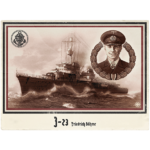
After failing to build the 37-class destroyers for the Atlantic in 1938, the Kriegsmarine returned to building a ship that would be suited to operating in different theaters. It was decided to develop the previously successful 1936 Roeder-class project. The primary distinction of the new eight 1936А Narvik-class ships was the transition to more powerful 150 mm main battery guns. But the size of "Narviks" was too small for this armament and didn't allow for the realization of its benefits, and at the same time, their seaworthiness was sacrificed. In later projects, the Germans returned to installing 127 mm main battery guns on destroyers.
The 1936A-class Z-23 lead ship joined the fleet on September 14, 1940. For her first year and a half of service, the bridge was occupied by Fregattenkapitan Friedrich Böhme (1899–1984), who had previously been commander on destroyer Anton Schmitt and was decorated with the Iron Cross, 1st Class, for the Battle of Narvik. Z-23 always escorted large raiders, including Bismarck, out into the ocean. She also actively operated in the Soviet Arctic and Norway. In May 1942, Böhme was transferred to a command position on land. During 1944 and 1945, he led submarine saboteur units in Normandy and Italy, and earned the Knight's Cross. From the spring of 1943, his former ship participated in battles in the Bay of Biscay until August 12, 1944, when British bombers dealt devastating damage to her in the La Pallice seaport.
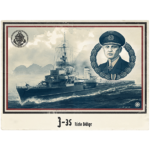
Z-35 was unlucky from the start. In 1939, she was one of nine destroyers of the new 1938B-class, but the Kriegsmarine abandoned the project due to it being inferior to the same-type ships of the enemy. Z-35 was ordered again based on the pre-existing Project 1936A. The start of construction was shifted and the ship was laid down only in the middle of 1941. Soon after, based on the operational experience of such destroyers, it was decided to stop using 150 mm main battery guns and bring back the time-tested 127 mm ones. Their AA defenses, as well as their radio and electronic equipment, were also improved. The ship's construction process continued from the middle of 1942, using the reworked 1936B project as the basis. Z-35 was brought into service only on September 22, 1943. She was the first of three destroyers of her class.
Corvette Captain Niels Bätge (1913–1944) became the ship's commander. A holder of the Knight's Cross, he successfully led a flotilla of torpedo boats in the English Channel between 1940 and 1943. Z-35 was his first large ship, and it was also his last. Between February and December 1944, the destroyer operated near the Baltic shores as part of the Kriegsmarine force tasked with preventing the Soviet forces from advancing. At first, the ship was even based in Tallinn—Bätge's hometown. But on December 12, 1944, in an estuary of the Gulf of Finland, the destroyer and the same-class ship Z-36 hit obstacle mines and were destroyed along with their commanders.
Reward
Completing this sub-collection provides the following reward:
![]() +24 hours Warships Premium time
+24 hours Warships Premium time
Kreigsmarine War Badges
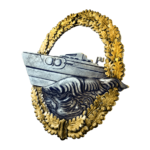
This badge was introduced on May 30, 1941, for the officers and privates who served on fast torpedo and patrol boats of the Kriegsmarine. It was awarded for participating in 12 attacks against the enemy, sinking an enemy ship, a successful raid, wounds received in action, and for demonstrating outstanding leadership qualities.
The badge was awarded to approximately 2,000 servicemen of the Kriegsmarine. It was awarded by the leader of Kriegsmarine's destroyers, who also led the torpedo boats.
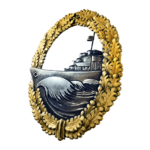
This badge was introduced on June 4, 1940, and was initially intended to be awarded to the crews of ships that took part in the Battle of Narvik. From October 1940, it was awarded to Kriegsmarine servicemen who served on destroyers and torpedo boats. A special badge for the latter was introduced in 1941.
It was awarded for participating in three battles against the enemy, or at least 12 raids, wounds received in action, and for demonstrating outstanding bravery and gallantry. It was also awarded to those who managed to survive after their ships had been destroyed. In total, the badge was awarded to 6,000 servicemen of the Kriegsmarine.
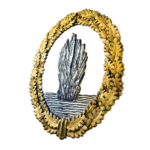
This badge was introduced on August 31, 1940, for the officers and privates who served on minesweeper and escort ships of the Kriegsmarine. It was awarded for participating in three operations, 25 or more days of escort missions, completing a high-risk mission in an area with a mine threat, and for honorable service of more than 6 months. The participants of especially successful operations, as well as those who were wounded in action or who had escaped from destroyed ships, also had the right to receive this badge.
Around 4,300 servicemen of the Kriegsmarine received this badge.
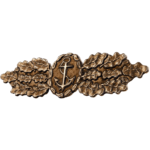
This badge was introduced on November 19, 1944, for all Kriegsmarine servicemen, except those who served on submarines who had already been given an award of similar quality. It was created based on the Close Combat Clasp award of the Wehrmacht, which was given to the best and most experienced veterans. It was worn above the left breast pocket.
The badge was awarded to those who had already fulfilled the conditions of receiving a regular war badge five times—this was an award for long honorable service under combat conditions. Given that the war badge was introduced at the end of the war, the number of those who received it is unknown.
Reward
Completing this sub-collection provides the following reward:
![]() +24 hours Warships Premium time
+24 hours Warships Premium time
Overall Rewards
Completing the entire collection provides the following rewards:
| Icon | Name | Notes |
|---|---|---|
 |
Iron Cross for tier VIII Gustav Julius Maerker |
Camouflage features:
[TBC] |
| Icon | Name | Notes |
|---|---|---|
 |
German Destroyers: Part 2 | Commemorative flag granted for completing the German Destroyers Collection |
